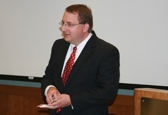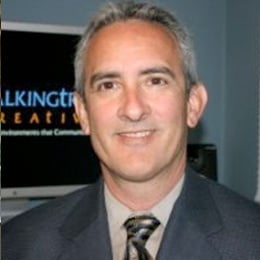Doug Wendt is a co-founder and senior partner with Wendt Partners.
The Story Behind an Educational Experiment

Good evening! I am honored to join you tonight to celebrate and support the Winston School, and I would like to thank Dr. Lewis and Elissa Cordrey for the opportunity to speak with you this evening.
My name is Doug Wendt, and I am proud to say that I had a small part to play in the making of history.
In the fall of 1981, my parents and I showed up on a Monday morning at the back entrance to the Sunday school wing of St. Paul's Episcopal Church on Main Street in Chatham Borough. Nine other students arrived as well, to join our first teacher, Mr. Nelson, and our first head of school, Mrs. Targan, in an educational experiment.
The late 1970s and early 1980s were, shall we say, 'interesting times' in education and the then-Chatham Township School District was going through great turmoil. I began as a student at Southern Boulevard Elementary, and the district had just opened their new, state-of-the-art Mountainview School to accommodate overcrowding. One thing that was in vogue during that era was the idea of the open classroom. At Mountainview, by the way, they took that concept literally – as in, many of the learning spaces had no actual walls.
Early in my learning journey, I observed a few things. The first thing was that teachers were doing what we might call 'closed classroom' teaching in these new 'open classroom' spaces.
"Students!
Look at me!
Listen to my lecture!
Open your books to page X!
Silence!"
And of course, if you take the 'sage-on-a-stage' model of 19th century learning and apply it to a late 20th century classroom with no walls, horrible acoustics and twice as many students as you had before, what do you get? Yes, that's right – chaos.
Yet, I didn't mind the chaos so much. I had been in a Montessori program at Chatham Township's Presbyterian church prior to starting grade school, so I was more than happy to roam the room, engage in new conversations, and explore every nook or book.
Alas, my teachers had a different view. Their view was:
He doesn't pay attention! He's unfocused! Won't stay in his seat! Too quick to answer! Doesn't wait his turn! Blurts out ideas! Scribbles in his workbook! Wanders the classroom! Talks with other students during quiet time!
No, the open classroom of the 1970s and early 1980s wasn't very kind to me.
Back then, just like today, once they decide that you are different, a race ensues to establish the right label for your differentness. And the assumption is that differentness is… a problem.
Just to be clear, I am not suggesting that children don't have actual learning differences. But there is a reason that the word "special" in our society, when attached to a child, automatically comes with a negative stigma and the idea of something being 'wrong'.
The issue with all of this is that, once you are told that your child has a 'problem', then you enter a new world, one that is often completely out of your control. Chances are, as parents you did what mine did: They said, well fine, if my child has a problem as you say, show me what it is, document it, and provide appropriate accommodation. Sounds logical. If only life was that simple!
In the span of a few years, I had been in four different classrooms across three different schools, none of which had any actual accommodation for whatever my disability or difference supposedly was, simply because, well, the program for special kids is over here now, or the classroom for children who are different is now over there. Shuttling. Labeling. Pull-out meetings with school psychologists, counselors, evaluators. More lost learning time.
And of course, this also meant that I had a less-than-ideal foundation for social relationships with my peers, since primary school students in the same neighborhood tend to go to the same school. Not me! I was making more transfers than a commuter trying to get from Chatham to JFK Airport in New York City by way of two railroads, a subway, an AirTrain, and a bus.
And to boot, we all know what happens when a child bounces around classrooms or schools. Not only is it socially disruptive to the child, but for the life of them no one among the educators can figure out how to evaluate the kid's progress.
Is he performing at grade level? Did he complete enough arithmetic? What about phonics? Heck, can he even read or write?
They wondered these things aloud – despite the fact that my psychologists and counselors and educational consultants were all writing these cheerful reports saying that they had met with a nice, respectful, curious, perfectly normal young man. Now, I wasn't perfect by any means -- after all, I was a young boy with plenty of energy -- but it never seemed to occur to the educators that if I was apparently doing poorly in the classroom -- and yet doing fine when in the sterile professional office of a clinician, where most young people would be intimidated and be feeling and acting deeply awkward and uncomfortable -- then maybe the problem wasn't so much me, as them? Maybe the problem wasn't the student, but rather, the school?
Yes, maybe, indeed.
And then there was Winston. An experiment. Something new. My parents were searching for solutions, and they had run out of patience with the existing options. Apparently, they were not alone, as there were nine other families in Morris, Essex and Union counties who were ready for something different as well. And so we came together at the beginning of the 1981-82 school year as the very first class, in very first year of the brand-new Winston School.
I learned to master my times-tables that year. I learned that when you mix every single paint color together in art class, you always get brown. I discovered dodge-ball. I fell in love with dogs – one of my fellow classmates had a beautiful German Shepherd named 'King'. At the end of the year, Mr. Nelson and Mrs. Targan presented me with a book to reward my effort and progress. The book's title? Tell Me Why, essentially a printed and bound version of today’s Wikipedia for curious children of the 1980s. I read the whole book cover to cover.
In the second year, we moved to Central Presbyterian Church in Summit. We were suddenly much bigger as a school, and I was thriving. One of the so-called 'problems' that my pre-Winston educators had identified was that I didn't write much at all, and when I did, it was generally illegible. So, my parents and Winston teachers started discussing this new thing called the personal computer. They wondered what would happen if I had one to use in school. That year, my parents purchased an Apple II computer from a new company started by two guys named Steve in California. And I had it installed on my desk. At school. In 1983.
Later that year, Winston purchased computers for the teachers. I ended up showing my teacher that year, Mrs. Hattan, how to use it.
That's what it was like at Winston. Little did I know how it would change my life.
After two years at the Summit campus of Winston, my parents started thinking about the post-Winston future – and what might come next.
We had a neighbor whose child attended one of the New England boarding schools, and he said it might be a good fit. I had spent four summers hiking and canoeing at the historic Keewaydin Camp in Vermont, and enjoyed it immensely.
So, we looked at boarding schools that could provide a similar experience. Cardigan Mountain School, located in New Hampshire and originally founded by leaders from Dartmouth College, had an opening in their sixth grade class. And, the admissions director assured us, I would be allowed to use my computer.
So I bid Winston goodbye after three years and headed off to the White Mountains. The first thing that I learned at Cardigan was that, even if the admissions director said all was good with something unique like, say, using a computer in the classroom in 1984, that doesn't necessarily mean everyone else agreed. There were some bumps along the way.
The dean of studies pulled me aside one day and warned me that if I stayed this dependent upon a computer, my life as an adult would be ruined. After all, he said, how could I ever write a check to pay for anything?
In seventh grade, my Dad and I stumbled upon the Tandy TRS 100, the world's first truly portable laptop computer. Now, I could carry my computer with me to the classroom, rather than what I had been doing, which was leaving the classroom to use my computer in a book closet!
Except that most of the teachers found my typing disruptive, and asked me to leave the classroom when I would type. I found it surprisingly relaxing to sit on the hallway floor to type essay tests!
The other thing I learned about was entrepreneurship. My Apple computer, when married to a dot-matrix printer, had the amazing ability to print signs, banners, logos and letterhead. I charged teachers and fellow students real money to create communications for them, and it filled my pockets quite handsomely. I was in business!
I learned a lot about myself in those years, too. By the time I graduated from Cardigan -- a pre-preparatory boarding school for grades six through nine -- I left as the school valedictorian and winner of the Founder's Prize for excellence in leadership. I was accepted to The Hotchkiss School in Lakeville, Connecticut. At Hotchkiss, I encountered the Macintosh, the world's first fully graphical personal computer. Thanks to the Mac, I learned how to use page layout software and a laser printer to create professional-quality publications.
My first project was a newsletter I produced for a nonprofit that I was volunteering for at the time. The nonprofit's executive director asked me if they could include the newsletter in their annual fundraising mailing, and I agreed. Later, I was told that it was the most successful fundraising appeal in the organization's history, thanks in no small part to my newsletter serving as a centerpiece.
From Hotchkiss, I decided to take charge and accelerate the game a bit. I was offered an opening in the professional writing program at Baylor University in Texas a year early, and I matriculated as a freshman after eleventh grade.
After two years in Texas, I became fascinated with philosophy and the liberal arts and decided to transfer to Franciscan University, a small Catholic liberal arts college in Ohio, where I studied the humanities and great books. There, I founded an academic journal called Humanitas, which my roommate and I designed on the Macintosh. We intended it to be a resource for student scholarship, but it was so well received that PhD academics from all around the world submitted papers for our consideration.
It was also at Franciscan University that I discovered the internet, beginning with a dial-up, text-only service called Delphi. As a result, I created an internet connection for myself and my classmates, and did it a full year before the university itself joined the internet revolution.
I graduated with a Bachelor of Arts degree in Philosophy, and entered the workforce. What did I do with my philosophy degree? Well, I created communications on my computer, of course! My first career position was with an educational publisher in Philadelphia, editing magazines and marketing a wide range of books. The internet was new, but I had already been using it. Graphic design was still new, too, but I had been creating graphics on the Mac for years. Publishing had been the province of only a few, due to the costs involved – but with a desktop laser printer, I had been a publisher already.
In short, I was ahead of the curve.
Today, I am the president of a business consulting firm now headquartered in Queens, NYC and serving clients around the world, where I advise the CEOs of companies on how to be different – how to differentiate, communicate and dominate their markets.
I serve on the graduate faculty at the American University School of Communication in Washington, D.C., where I teach communication management. And I mentor college students on career planning and strategy with a focus on developing leadership and communication skills.
I look back now, and I see clearly that it all started with Winston.
Our society, the way it is designed and the manner in which it has evolved, is inextricably drawn toward sameness. Sameness is society's comfort zone. Race, gender, language, nationality, you name it -- people so often demand to have something in common with one another, no matter how benign that commonality may be.
And yet, it's differentness that makes the world go around. People who are different are leaders -- not always because they want to be, but because they have to be. When you're different, you have a choice to make. Are you going to give in and accept the labels thrown at you, or are you going to stand for your own vision and ideals?
I haven't yet mentioned the label I had assigned to me before Winston. The answer is that I was diagnosed with dysgraphia, which affects handwriting and fine motor control skills. And that this, in turn, led me to be more verbal, talkative, socially intense and outgoing by nature – which is, of course, exactly what we want in our children (except in the classroom!).
Yet, I was told that my learning “disability” would forever limit my prospects in life. One change of school, one new computer and one completely new mindset later, and my so-called disability was not only downshifted into a difference – it was actually transformed into a powerful advantage, a secret weapon.
I am who I am today because of that experience, just as your children will be unique and dynamic and innovative tomorrow because of that experience as well. Society suggests that most of us are in one monolithic grouping called 'normal' or 'average', and that those who don't fit the mold are 'different'. In reality, every child is different. The only question is whether their parents, educators and peers will recognize it early enough and do something radical to support it.
I am reminded of the world-renowned TED talk given by British educator Sir Kenneth Robinson, in which he tells the story of one Mrs. Lynne, a mother whose daughter wasn’t a huge fan of sitting still in school, and was promptly labeled as a child with a problem, a disorder. Distressed, the mother took her daughter to see a doctor for evaluation. After a lengthy meeting with the clinician, her daughter came bounding out, all smiles.
The doctor then spoke with the mother. His words:
"Your child is not sick, Mrs. Lynne. She's a dancer."
The mother promptly transferred her daughter to a dance school, and that daughter grew up to become Gillian Lynne, a world-class dancer and choreographer whose work you may have heard of. She was the choreographer for Phantom of the Opera. And CATS.
Every child is like that in one way or another, but Winston exists for the children whose parents took the bold step of seeing their child's differentness as an opportunity -- an opportunity that says, if you give a child the right environment in which to grow, they will blossom in ways you cannot possibly have expected.
And that is the essence of Winston.
Winston taught me on so many levels to be proud of who I am. I have every confidence that Winston is doing the same for your child.
We started an experiment back in 1981 – an experiment with ten students and two educators, to try something different. I am pleased to be back with you today, thirty-three years later, to report on the results.
The answer is: the experiment worked.
Thank you.






